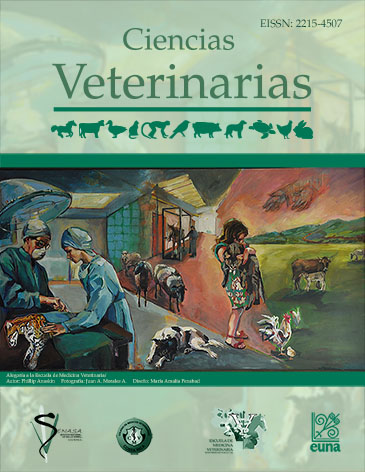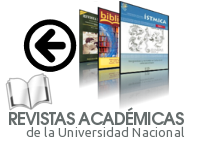Intervalo Parto-Concepción en Ganado Lechero Especializado de Costa Rica
DOI:
https://doi.org/10.15359/rcv.37-1.3Keywords:
dairy, reproduction, efficiency, epidemiology, herd healthAbstract
An efficient dairy herd must produce a living, healthy calf per cow per year, and it should be accomplished with a Calving-Conception Interval (CCI) no greater than 100 days. Objective: Describe CCI epidemiological aspects in specialized dairy cattle in Costa Rica during the 2000-2013 period. Materials and methods: A historical prospective study was conducted with 434,708 entries from the VAMPP Bovino 3.0 software. CCI was estimated for intrinsic and extrinsic variables in cattle. Data was analyzed using descriptive statistics (mean, median, standard deviation, 95% confidence interval). Furthermore, means and percentages were compared using T-Student and Chi-square tests, respectively, while the risk of a CCI higher than 100 days was calculated by the rate radio (RR), using Poisson regression. Results: Over 50% of cattle had a CCI greater than 100 days, with a general mean of 136.6 days (± 84.2). CCI was higher in first lactation animals (142.0 ± 88.4 days) (P<0.001). It was also higher in Holstein cattle (148.7±85.9 days) than in Brown Swiss and Jersey cattle (P < 0.0001). Average CCI was higher in cattle with dystocic or cesarean deliveries (P < 0.001). Cattle with high milk production (5900-10100 kg/305d) exhibited a greater CCI (141.5 d ± 80.8 d). CCI of animals living in the dry forest was almost 10 days higher than those living in other areas (P<0.01). Those same weather conditions were the ones that showed the highest risk (rate ratio) with a CCI greater than 100 days. Conclusion. CCI is influenced by intrinsic and extrinsic variables. Therefore, herd management should focus on modifiable variables, such as heat detection and efficient artificial insemination.
References
Arbel, R., Bigun, Y, Ezra, E., Sturman, H., & Hojman, D. 2001. The Effect of Extended Calving Intervals in High Lactating Cows on Milk Production and Profitability J. Dairy Sci. 84 (3):600–608. doi:10.3168/jds.S0022-0302(01)74513-4
Ashworth, C.J., Toma, L.M., & Hunterm, M.G. 2009. Nutritional effects on oocyte and embryo development in mammals: implications for reproductive efficiency and environmental sustainability. Philos. Trans. R. Soc. (364): 3351–3361. doi: 10.1098/rstb.2009.0184
Aungier, S.P.M., Roche, J.F., Diskin, M.G., & Crowe, M.A. 2014. Risk factors that affect reproductive target achievement in fertile dairy cows. J. Dairy Sci. 97(6): 3472–87. doi: 10.3168/jds.2013-7404
Balzarini, M., Gonzalez, L., Tablada, M., Casanoves, F., Di Rienzo, J.A., & Robledo, C. 2008. Infostat versión 2008 (Universidad de Córdoba, Ed.). Brujas, Argentina.
Bonita, R., Beaglehole, R., & Kjellstrom, T. 2008. Epidemiología Básica. 2nd Edition. Organización Panamericana de la Salud, Washington D.C.
Bouraoui, R., Lahmar, M., Majdoub, A., Djemali, N., & R. Belyea. 2002. The relationship of temperature-humidity index with milk production of dairy cows in a Mediterranean climate. Anim. Res 51: 479–491. doi: 10.1051/animres:2002036
Brand, A., Noordhuizen, J.P.T.M., & Schukken, Y.H. 1997. Herd Health and Production Management in dairy practice. 2nd Edition. Wageningen Pers.
Buckley, F., O’Sullivan, K., Mee, J.F., Evans, R.D., & Dillon, P. 2003. Relationships Among Milk Yield, Body Condition, Cow Weight, and Reproduction in Spring-Calved Holstein-Friesians. J. Dairy Sci. 86(7): 2308–2319. doi: 10.3168/jds.S0022-0302(03)73823-5
Castillo-Badilla, G., Salazar-Carranza, M., Murillo-Herrera, J., Hueckmann-Voss, F., & Romero-Zúñiga, J.J. 2015. Efecto de la edad al primer parto sobre parámetros reproductivos en la primera lactancia de vacas Holstein y Jersey de Costa Rica 33(506): 33–45. doi: 10.15359/rcv.33-1.2
Cook, J.G., & Green, M.J. 2016. Use of early lactation milk recording data to predict the calving to conception interval in dairy herds. J. Dairy Sci. 99 (6): 4699–4706. http://dx.doi.org/10.3168/jds. 2015-10264.
Dawson, B., & Trapp, R.G. 2005. Bioestadística Médica. 4th Edition. Manual Moderno, México D.F. p.404
DeGaris, P., Lean, I., Rabiee, A., & Heuer, C. 2010. Effects of increasing days of exposure to prepartum transition diets on reproduction and health in dairy cows. Aust. Vet. J. 88(3): 84–92. doi: 10.1111/j.1751-0813.2009.00529.x
De Vries, A., Van Leeuwen, J., & Thatcher, W.W. 2005. Economics of Improved Reproductive Performance in Dairy Cattle (AN156). Department of Animal Sciences, Florida Cooperative Extension Service, Institute of Food and Agricultural Sciences, University of Florida. http://ufdc.ufl.edu/IR00003765/00001 (Accessed: 11 december 2018)
Dijkhuizen, A. A., Stelwagen, J., & Renkema, J. A. 1985. Economic aspects of reproductive failure in dairy cattle. I. Financial loss at farm level. Preventive Veterinary Medicine. 3 (3):251-263. doi: 10.1016/0167-5877(85)90020-0
Dikmen, S., & Hansen, P.J. 2009. Is the temperature-humidity index the best indicator of heat stress in lactating dairy cows in a subtropical environment? J. Dairy Sci (92): 109–116. doi:10.3168/jds.2008-1370
Ducrot, C., Y.T. Gröhn, F. Bugnard, Y. Senlis, P. Sulpice, R.O. Gilbert, & Bugnard, F. 1999. A field study on estrus detection in lactating beef cattle. Vet. Res (30): 87-98.
Eaglen, S., M. Coffey, J. Woolliams, R. Mrode, & Wall, E. 2011. Phenotypic effects of calving ease on the subsequent fertility and milk production of dam and calf in UK Holstein-Friesian heifers. J. Dairy Sci. 94: 5413–5423. doi: 10.3168/jds.2010-4040
Echternkamp, S.E., & Gregory, K.E. 1999. Effects of Twinning on Postpartum Reproductive Performance in Cattle Selected for Twin Births. J. Anim. Sci. 77(1):48-60.
Gebeyehu, G., Belihu, K., & Berihun, A. 2007. Effect of parity, season and year on reproductive performance and herd life of Friesian cows at Stella private dairy farm, Ethiopia. Livest. Res. Rural Dev. 19(7)
Gröhn, Y.T., & Rajala-Schultz, P.J. 2000. Epidemiology of reproductive performance in dairy cows. Anim. Reprod. Sci. 60–61: 605–614. doi: 10.1016/S0378-4320(00)00085-3
Gür, S., & Dogan, N. 2010. The possible role of bovine herpesvirus type-4 infection in cow infertility. Anim. Sci. J. (81): 304–308. doi: 10.1111/j.1740-0929.2010.00743.x
Han, Y.-K., & Kim, I.-H. 2005. Risk factors for retained placenta and the effect of retained placenta on the occurrence of postpartum diseases and subsequent reproductive performance in dairy cows. J. Vet. Sci. 6(1): 53–59.
Heinrichs, A.J., & Heinrichs, B.S. 2011. A prospective study of calf factors affecting first-lactation and lifetime milk production and age of cows when removed from the herd. J. Dairy Sci. 94(1): 336–341. doi: 10.3168/jds.2010-3170
Holmann, F.J., Shumway, R., Blake, R.W., Schwart, R.B., & Sudweeks, E.M. 1984. Economic Value of Days Open for Holstein Cows of Alternative Milk Yields with Varying Calving Intervals. J. Dairy Sci. 67 (3): 636-643. doi: 10.3168/jds.S0022-0302(84)81349-1
Hosmer, D.W., & Lemeshow, S. 1980. Goodness of fit tests for the multiple logistic regression model. Commun. Stat. - Theory Methods, 9(10): 1043–1069.
Hossein-Zadeh, N. 2010. The effect of twinning on milk yield, dystocia, calf birth weight and open days in Holstein dairy cows of Iran. J. Anim. Phisiology Anim. Nutr. 94: 780–787. doi: 10.1111/j.1439-0396.2009.00963.x
Lammoglia-Villagómez, M.Á., Ávila-García, J., Alarcón-Zapata, M.A., Cabrera-Núñez, A., Gutiérrez-Rodríguez, A., & Daniel-Rentería, I. 2013. Rendimientos productivos y reproductivos de vacas lecheras en el primer cruzamiento rotativo en el altiplano del centro de méxico. Vet. México 44(1): 17–22.
López de Maturana, E., Legarra, A., Varona, L., & Ugarte, E. 2007. Analysis of Fertility and Dystocia in Holsteins Using Recursive Models to Handle Censored and Categorical Data. J. Dairy Sci. 90(4): 2012–2024. doi: 10.3168/jds.2005-442
Lucy, M.C. 2001. Reproductive Loss in High-Producing Dairy Cattle: Where Will It End? J. Dairy Sci. 84(6): 1277–1293. doi: 10.3168/jds.S0022-0302(01)70158-0
Mee, J.F. 2008. Prevalence and risk factors for dystocia in dairy cattle: A review. Vet. J. 176(1): 93–101. doi: 10.1016/j.tvjl.2007.12.032
Mestries, F. 2009. La crisis de la tortilla en los albores del sexenio de Felipe Calderón. ¿Libre mercado o ley de los monopolios? El Cotid. 155: 87–93.
Motlagh, M.K., Roohani, Z., Shahne, A.Z., & Moradi, M. 2013. Effects of age at calving, parity, year and season on reproductive performance of dairy cattle in Tehran and Qazvin Provinces, Iran. Res. Opin. Anim. Vet. Sci. 3(10): 337–342.
Murillo-Barrantes, J., Estrada-Konig, S., Rojas-Campos, J., Bolaños-Segura, M., Valverde-Altamirano, E., & Romero-Zúñiga, J.J. 2010. Efecto de partos gemelares sobre parámetros productivos y reproductivos en vacas de hatos lecheros especializados de Costa Rica. Rev. Ciencias Vet. 28(2): 69–87.
Nardone, A., Ronchi, B., Lacetera, N., Ranieri, M., & Bernabucci, U. 2010. Effects of climate changes on animal production and sustainability of livestock systems. Livestock Science. 130 (2010): 57–69. doi:10.1016/j.livsci.2010.02.011
Noordhuizen, J.P.T.M., Frankena, K., Thrusfield, M., & Graat, E.A. 2001. Application of Quantitative Methods in Veterinary Epidemiology. 2nd Edition. Wageningen Pers, The Netherlands.
Rodriguez-Martinez, H., Hultgren, J., Båge, R., Bergqvist, A., Svensson, C., Bergsten, C., Lidfors, L., Gunnarsson, S., Algers, B., Emanuelson, U., Berglund, B., Andersson, G., Haard, M., Lindhé, B., Stalalhammar, H., & Gustafsson, H. 2008. Reproductive performance in high-producing dairy cows : Can we sustain it under current practice ? https://pub.epsilon.slu.se/3502/1/RodriguezM_etal_090122.pdf. (Accessed 12 december 2018).
Roelofs, J., López-Gatius, F., Hunter, R.H.F., van Eerdenburg, F.J.C.M., & Hanzen, C. 2010. When is a cow in estrus? Clinical and practical aspects. Theriogenology 74(3): 327–344. doi: 10.1016/j.theriogenology.2010.02.016
Romero, J., Dávila, G., Beita, G., & Dolz, G. 2015. Relación entre el estado serológico a Leucosis Bovina Enzoótica y parámetros reproductivos en hatos lecheros especializados de Costa Rica. Agron. Costarric. 39(2): 7–18.
Schüller, L.K., Burfeind, O., & Heuwieser, W. 2014. Impact of heat stress on conception rate of dairy cows in the moderate climate considering different temperature-humidity index thresholds, periods relative to breeding, and heat load indices. Theriogenology (81): 1050–1057. doi: 10.1016/j.theriogenology.2014.01.029
Sheldon, I.M., Williams, E.J., Miller, A.N.A., Nash, D.M., & Herath, S. 2008. Uterine diseases in cattle after parturition. Vet. J. 176: 115–121. doi: 10.1016/j.tvjl.2007.12.031
Van Saun, R.. Transition Cow Nutrition and Management: The Key to Herd Reproductive Performance. Penn State Univ.: 1–14. https://www.researchgate.net/publication/242724156_Transition_Cow_Nutrition_and_Management_The_Key_to_Herd_Reproductive_Performance. (Accessed 5 november 2018)
Vargas-Leitón, B., & Cuevas-Abrego, M. 2009. Modelo estocástico para estimación de valores económicos de rasgos productivos y funcionales en bovinos lecheros. Agrociencia 43(8): 881–893.
Vargas-Leitón, B., Marín-Marín, Y., & Romero-Zúñiga, J.J. 2012. Comparación Bioeconómica de grupos raciales Holstein, Jersey y Holstein x Jersey en Costa Rica. Agron. Mesoam. 23(2): 329–342.
Vargas, B., Van der Lende, T., Baaijen, M., & Van Arendonk, J.A.M.. 1998. Event-Time Analysis of Reproductive Traits of Dairy Heifers. J. Dairy Sci. 81(11): 2881–2889. doi: 10.3168/jds.S0022-0302(98)75848-5
Walsh, S.W., Williams, E.J., & Evans, A.C. 2011. A review of the causes of poor fertility in high milk producing dairy cows. Anim. Reprod. Sci. 123(3–4): 127–138. doi: 10.1016/j.anireprosci.2010.12.001
Washburn, S.P., Silvia, W.J., Brown, C.H., Mcdaniel, B.T., & Mcallister, A.J. 2002. Trends in Reproductive Performance in Southeastern Holstein and Jersey DHI Herds. J . Dairy Sci 85 (1): 244–251. doi: 10.3168/jds.S0022-0302(02)74073-3
Wathes, D.C., Cheng, Z., Bourne, N., Taylor, V.J., Coffey, M.P., & Brotherstone, S. 2007a. Differences between primiparous and multiparous dairy cows in the inter-relationships between metabolic traits, milk yield and body condition score in the periparturient period. Domest. Anim. Endocrinol. 33(2): 203–225. doi: 10.1016/j.domaniend.2006.05.004
Wathes, D., Fenwick, M., Cheng, Z., Bourne, N., Llewellyn, S., Morris, D., Kenny, D., Murphy, J., & Fitzpatrick, R. 2007b. Influence of negative energy balance on cyclicity and fertility in the high producing dairy cow. Theriogenology 68, Suppl 1: S232–S241. doi: 10.1016/j.theriogenology.2007.04.006
Watters, R.D., Wiltbank, M.C., Guenther, J.N., Brickner, A.E., Rastani, R.R., Fricke, P.M., & Grummer, R.R. 2009. Effect of dry period length on reproduction during the subsequent lactation. J. Dairy Sci. 92(7): 3081–3090. doi: 10.3168/jds.2008-1294
West, J.W., Mullinix, B.G., & Bernard, J.K. 2003. Effects of hot, humid weather on milk temperature, dry matter intake, and milk yield of lactating dairy cows. J. Dairy Sci. 86(1): 232–242. doi: 10.3168/jds.S0022-0302(03)73602-9
Published
How to Cite
Issue
Section
License
Licensing of articles
All articles will be published under a license:

Licencia Creative Commons Atribución-NoComercial-SinDerivadas 3.0 Costa Rica.
Access to this journal is free of charge, only the article and the journal must be cited in full.
Intellectual property rights belong to the author. Once the article has been accepted for publication, the author assigns the reproduction rights to the Journal.
Ciencias Veterinarias Journal authorizes the printing of articles and photocopies for personal use. Also, the use for educational purposes is encouraged. Especially: institutions may create links to specific articles found in the journal's server in order to make up course packages, seminars or as instructional material.
The author may place a copy of the final version on his or her server, although it is recommended that a link be maintained to the journal's server where the original article is located.
Intellectual property violations are the responsibility of the author. The company or institution that provides access to the contents, either because it acts only as a transmitter of information (for example, Internet access providers) or because it offers public server services, is not responsible.







